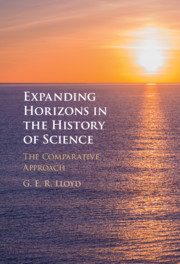Refine search
Actions for selected content:
13588 results in History of science and technology
Introduction
-
- Book:
- Expanding Horizons in the History of Science
- Published online:
- 17 August 2021
- Print publication:
- 26 August 2021, pp 1-7
-
- Chapter
-
- You have access
- Open access
- HTML
- Export citation
Bibliography
-
- Book:
- Expanding Horizons in the History of Science
- Published online:
- 17 August 2021
- Print publication:
- 26 August 2021, pp 135-147
-
- Chapter
-
- You have access
- Open access
- HTML
- Export citation
Index
-
- Book:
- Expanding Horizons in the History of Science
- Published online:
- 17 August 2021
- Print publication:
- 26 August 2021, pp 148-156
-
- Chapter
-
- You have access
- Open access
- HTML
- Export citation
Chapter 6 - Definitions and the Problems of Foreclosure
-
- Book:
- Expanding Horizons in the History of Science
- Published online:
- 17 August 2021
- Print publication:
- 26 August 2021, pp 75-85
-
- Chapter
-
- You have access
- Open access
- HTML
- Export citation
Copyright page
-
- Book:
- Expanding Horizons in the History of Science
- Published online:
- 17 August 2021
- Print publication:
- 26 August 2021, pp iv-iv
-
- Chapter
-
- You have access
- Open access
- HTML
- Export citation
Chapter 3 - Demystifying the Greek Miracle
-
- Book:
- Expanding Horizons in the History of Science
- Published online:
- 17 August 2021
- Print publication:
- 26 August 2021, pp 32-43
-
- Chapter
-
- You have access
- Open access
- HTML
- Export citation
Chapter 10 - Mind, Body, Heart, Brain, Soul, Spirit
-
- Book:
- Expanding Horizons in the History of Science
- Published online:
- 17 August 2021
- Print publication:
- 26 August 2021, pp 115-128
-
- Chapter
-
- You have access
- Open access
- HTML
- Export citation
Chapter 2 - Translatability, Intelligibility, Revisability
-
- Book:
- Expanding Horizons in the History of Science
- Published online:
- 17 August 2021
- Print publication:
- 26 August 2021, pp 23-31
-
- Chapter
-
- You have access
- Open access
- HTML
- Export citation
Figures
-
- Book:
- Expanding Horizons in the History of Science
- Published online:
- 17 August 2021
- Print publication:
- 26 August 2021, pp vi-vi
-
- Chapter
-
- You have access
- Open access
- HTML
- Export citation
Chapter 5 - The Criteria of Theories, Simplicity for Instance
-
- Book:
- Expanding Horizons in the History of Science
- Published online:
- 17 August 2021
- Print publication:
- 26 August 2021, pp 57-70
-
- Chapter
-
- You have access
- Open access
- HTML
- Export citation
Chapter 5a - Supplementary Note on Greek Astronomical Models
-
- Book:
- Expanding Horizons in the History of Science
- Published online:
- 17 August 2021
- Print publication:
- 26 August 2021, pp 71-74
-
- Chapter
-
- You have access
- Open access
- HTML
- Export citation

Expanding Horizons in the History of Science
-
- Published online:
- 17 August 2021
- Print publication:
- 26 August 2021
-
- Book
-
- You have access
- Open access
- Export citation
Revolutionary electricity in 1790: shock, consensus, and the birth of a political metaphor
-
- Journal:
- The British Journal for the History of Science / Volume 54 / Issue 3 / September 2021
- Published online by Cambridge University Press:
- 29 July 2021, pp. 257-275
- Print publication:
- September 2021
-
- Article
- Export citation
‘A method for safe transmission’: the microscope slides of the American Postal Microscopical Club
-
- Journal:
- The British Journal for the History of Science / Volume 54 / Issue 4 / December 2021
- Published online by Cambridge University Press:
- 29 July 2021, pp. 403-422
- Print publication:
- December 2021
-
- Article
-
- You have access
- Open access
- HTML
- Export citation
‘Ancient lore with modern appliances’: networks, expertise, and the making of the Open Polar Sea, 1851–1853
-
- Journal:
- The British Journal for the History of Science / Volume 54 / Issue 3 / September 2021
- Published online by Cambridge University Press:
- 22 July 2021, pp. 277-299
- Print publication:
- September 2021
-
- Article
-
- You have access
- Open access
- HTML
- Export citation
Frontier atmosphere: observation and regret at Chinese weather stations in Tibet, 1939–1949
-
- Journal:
- The British Journal for the History of Science / Volume 54 / Issue 3 / September 2021
- Published online by Cambridge University Press:
- 13 July 2021, pp. 361-379
- Print publication:
- September 2021
-
- Article
- Export citation
Framing Asian atmospheres: imperial weather science and the problem of the local c. 1880–1950
-
- Journal:
- The British Journal for the History of Science / Volume 54 / Issue 3 / September 2021
- Published online by Cambridge University Press:
- 12 July 2021, pp. 301-304
- Print publication:
- September 2021
-
- Article
-
- You have access
- HTML
- Export citation

Revealed Sciences
- The Natural Sciences in Islam in Seventeenth-Century Morocco
-
- Published online:
- 08 July 2021
- Print publication:
- 08 July 2021
List of Figures
-
- Book:
- Revealed Sciences
- Published online:
- 08 July 2021
- Print publication:
- 08 July 2021, pp ix-ix
-
- Chapter
- Export citation
Acknowledgments
-
- Book:
- Revealed Sciences
- Published online:
- 08 July 2021
- Print publication:
- 08 July 2021, pp xix-xxiv
-
- Chapter
- Export citation
